| Listing 1 - 8 of 8 |
Sort by
|
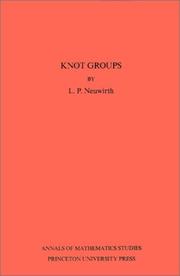
ISBN: 0691079919 1400882036 9780691079912 Year: 1965 Volume: 56 Publisher: Princeton (N.J.): Princeton university press,
Abstract | Keywords | Export | Availability | Bookmark
 Loading...
Loading...Choose an application
- Reference Manager
- EndNote
- RefWorks (Direct export to RefWorks)
The description for this book, Knot Groups. Annals of Mathematics Studies. (AM-56), Volume 56, will be forthcoming.
Topology --- 512 --- Algebra --- 512 Algebra --- Knot theory. --- Knots (Topology) --- Low-dimensional topology --- Abelian group. --- Alexander duality. --- Alexander polynomial. --- Algebraic theory. --- Algorithm. --- Analytic continuation. --- Associative property. --- Automorphism. --- Axiom. --- Bijection. --- Binary relation. --- Calculation. --- Central series. --- Characterization (mathematics). --- Cobordism. --- Coefficient. --- Cohomology. --- Combinatorics. --- Commutator subgroup. --- Complete theory. --- Computation. --- Conjugacy class. --- Conjugate element (field theory). --- Connected space. --- Connectedness. --- Coprime integers. --- Coset. --- Covering space. --- Curve. --- Cyclic group. --- Dehn's lemma. --- Determinant. --- Diagonalization. --- Diagram (category theory). --- Dimension. --- Direct product. --- Equivalence class. --- Equivalence relation. --- Euclidean space. --- Euler characteristic. --- Existential quantification. --- Fiber bundle. --- Finite group. --- Finitely generated module. --- Frattini subgroup. --- Free abelian group. --- Fundamental group. --- Geometry. --- Group ring. --- Group theory. --- Group with operators. --- Hausdorff space. --- Homeomorphism. --- Homology (mathematics). --- Homomorphism. --- Homotopy group. --- Homotopy. --- Identity matrix. --- Inner automorphism. --- Interior (topology). --- Intersection number (graph theory). --- Knot group. --- Linear combination. --- Manifold. --- Mathematical induction. --- Monomorphism. --- Morphism. --- Morse theory. --- Natural transformation. --- Non-abelian group. --- Normal subgroup. --- Orientability. --- Permutation. --- Polynomial. --- Presentation of a group. --- Principal ideal domain. --- Principal ideal. --- Root of unity. --- Semigroup. --- Simplicial complex. --- Simply connected space. --- Special case. --- Square matrix. --- Subgroup. --- Subset. --- Summation. --- Theorem. --- Three-dimensional space (mathematics). --- Topological space. --- Topology. --- Torus knot. --- Transfinite number. --- Trefoil knot. --- Trichotomy (mathematics). --- Trivial group. --- Triviality (mathematics). --- Two-dimensional space. --- Unit vector. --- Wreath product.
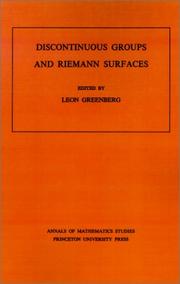
ISBN: 0691081387 1400881641 9780691081380 Year: 1974 Volume: 79 Publisher: Princeton: Princeton university press,
Abstract | Keywords | Export | Availability | Bookmark
 Loading...
Loading...Choose an application
- Reference Manager
- EndNote
- RefWorks (Direct export to RefWorks)
Study 79 contains a collection of papers presented at the Conference on Discontinuous Groups and Ricmann Surfaces at the University of Maryland, May 21-25, 1973. The papers, by leading authorities, deal mainly with Fuchsian and Kleinian groups, Teichmüller spaces, Jacobian varieties, and quasiconformal mappings. These topics are intertwined, representing a common meeting of algebra, geometry, and analysis.
Group theory --- Complex analysis --- Number theory --- RIEMANN SURFACES --- Discontinuous groups --- congresses --- Congresses --- Riemann surfaces --- Congresses. --- Groupes discontinus --- Combinatorial topology --- Functions of complex variables --- Surfaces, Riemann --- Functions --- Abelian variety. --- Adjunction (field theory). --- Affine space. --- Algebraic curve. --- Algebraic structure. --- Analytic function. --- Arithmetic genus. --- Automorphism. --- Bernhard Riemann. --- Boundary (topology). --- Cauchy sequence. --- Cauchy–Schwarz inequality. --- Cayley–Hamilton theorem. --- Closed geodesic. --- Combination. --- Commutative diagram. --- Commutator subgroup. --- Compact Riemann surface. --- Complex dimension. --- Complex manifold. --- Complex multiplication. --- Complex space. --- Complex torus. --- Congruence subgroup. --- Conjugacy class. --- Convex set. --- Cyclic group. --- Degeneracy (mathematics). --- Diagram (category theory). --- Diffeomorphism. --- Differential form. --- Dimension (vector space). --- Disjoint sets. --- E7 (mathematics). --- Endomorphism. --- Equation. --- Equivalence class. --- Euclidean space. --- Existence theorem. --- Existential quantification. --- Finite group. --- Finitely generated group. --- Fuchsian group. --- Fundamental domain. --- Fundamental lemma (Langlands program). --- Fundamental polygon. --- Galois extension. --- Holomorphic function. --- Homeomorphism. --- Homology (mathematics). --- Homomorphism. --- Hurwitz's theorem (number theory). --- Inclusion map. --- Inequality (mathematics). --- Inner automorphism. --- Intersection (set theory). --- Irreducibility (mathematics). --- Isomorphism class. --- Isomorphism theorem. --- Jacobian variety. --- Jordan curve theorem. --- Kleinian group. --- Limit point. --- Mapping class group. --- Metric space. --- Monodromy. --- Monomorphism. --- Möbius transformation. --- Non-Euclidean geometry. --- Orthogonal trajectory. --- Permutation. --- Polynomial. --- Power series. --- Projective variety. --- Quadratic differential. --- Quadric. --- Quasi-projective variety. --- Quasiconformal mapping. --- Quotient space (topology). --- Rectangle. --- Riemann mapping theorem. --- Riemann surface. --- Schwarzian derivative. --- Simply connected space. --- Simultaneous equations. --- Special case. --- Subgroup. --- Subsequence. --- Surjective function. --- Symmetric space. --- Tangent space. --- Teichmüller space. --- Theorem. --- Topological space. --- Topology. --- Uniqueness theorem. --- Unit disk. --- Variable (mathematics). --- Winding number. --- Word problem (mathematics). --- RIEMANN SURFACES - congresses --- Discontinuous groups - Congresses --- Geometrie algebrique --- Fonctions d'une variable complexe --- Surfaces de riemann

ISBN: 0691085773 1306986230 0691602891 0691632340 1400861063 9780691085777 Year: 1990 Volume: 39 Publisher: Princeton (N.J.): Princeton university press,
Abstract | Keywords | Export | Availability | Bookmark
 Loading...
Loading...Choose an application
- Reference Manager
- EndNote
- RefWorks (Direct export to RefWorks)
One of the great achievements of contemporary mathematics is the new understanding of four dimensions. Michael Freedman and Frank Quinn have been the principals in the geometric and topological development of this subject, proving the Poincar and Annulus conjectures respectively. Recognition for this work includes the award of the Fields Medal of the International Congress of Mathematicians to Freedman in 1986. In Topology of 4-Manifolds these authors have collaborated to give a complete and accessible account of the current state of knowledge in this field. The basic material has been considerably simplified from the original publications, and should be accessible to most graduate students. The advanced material goes well beyond the literature; nearly one-third of the book is new. This work is indispensable for any topologist whose work includes four dimensions. It is a valuable reference for geometers and physicists who need an awareness of the topological side of the field.Originally published in 1990.The Princeton Legacy Library uses the latest print-on-demand technology to again make available previously out-of-print books from the distinguished backlist of Princeton University Press. These editions preserve the original texts of these important books while presenting them in durable paperback and hardcover editions. The goal of the Princeton Legacy Library is to vastly increase access to the rich scholarly heritage found in the thousands of books published by Princeton University Press since its founding in 1905.
Differential topology --- Four-manifolds (Topology) --- Trois-variétés (Topologie) --- Vier-menigvuldigheden (Topologie) --- 4-dimensional manifolds (Topology) --- 4-manifolds (Topology) --- Four dimensional manifolds (Topology) --- Manifolds, Four dimensional --- Low-dimensional topology --- Topological manifolds --- 4-manifold. --- Ambient isotopy. --- Annulus theorem. --- Automorphism. --- Baire category theorem. --- Bilinear form. --- Boundary (topology). --- CW complex. --- Category of manifolds. --- Central series. --- Characterization (mathematics). --- Cohomology. --- Commutative diagram. --- Commutative property. --- Commutator subgroup. --- Compactification (mathematics). --- Conformal geometry. --- Connected sum. --- Connectivity (graph theory). --- Cyclic group. --- Diagram (category theory). --- Diameter. --- Diffeomorphism. --- Differentiable manifold. --- Differential geometry. --- Dimension. --- Disk (mathematics). --- Duality (mathematics). --- Eigenvalues and eigenvectors. --- Embedding problem. --- Embedding. --- Equivariant map. --- Fiber bundle. --- Four-dimensional space. --- Fundamental group. --- General position. --- Geometry. --- H-cobordism. --- Handlebody. --- Hauptvermutung. --- Homeomorphism. --- Homology (mathematics). --- Homology sphere. --- Homomorphism. --- Homotopy group. --- Homotopy sphere. --- Homotopy. --- Hurewicz theorem. --- Hyperbolic geometry. --- Hyperbolic group. --- Hyperbolic manifold. --- Identity matrix. --- Intermediate value theorem. --- Intersection (set theory). --- Intersection curve. --- Intersection form (4-manifold). --- Intersection number (graph theory). --- Intersection number. --- J-homomorphism. --- Knot theory. --- Lefschetz duality. --- Line–line intersection. --- Manifold. --- Mapping cylinder. --- Mathematical induction. --- Metric space. --- Metrization theorem. --- Module (mathematics). --- Normal bundle. --- Parametrization. --- Parity (mathematics). --- Product topology. --- Pullback (differential geometry). --- Regular homotopy. --- Ring homomorphism. --- Rotation number. --- Seifert–van Kampen theorem. --- Sesquilinear form. --- Set (mathematics). --- Simply connected space. --- Smooth structure. --- Special case. --- Spin structure. --- Submanifold. --- Subset. --- Support (mathematics). --- Tangent bundle. --- Tangent space. --- Tensor product. --- Theorem. --- Topological category. --- Topological manifold. --- Transversal (geometry). --- Transversality (mathematics). --- Transversality theorem. --- Uniqueness theorem. --- Unit disk. --- Vector bundle. --- Whitehead torsion. --- Whitney disk.
Book
ISBN: 0691080275 069162612X 0691652449 140087453X Year: 1974 Publisher: Princeton (N.J.) Princeton University Press
Abstract | Keywords | Export | Availability | Bookmark
 Loading...
Loading...Choose an application
- Reference Manager
- EndNote
- RefWorks (Direct export to RefWorks)
The theory of Riemann surfaces has a geometric and an analytic part. The former deals with the axiomatic definition of a Riemann surface, methods of construction, topological equivalence, and conformal mappings of one Riemann surface on another. The analytic part is concerned with the existence and properties of functions that have a special character connected with the conformal structure, for instance: subharmonic, harmonic, and analytic functions.Originally published in 1960.The Princeton Legacy Library uses the latest print-on-demand technology to again make available previously out-of-print books from the distinguished backlist of Princeton University Press. These editions preserve the original texts of these important books while presenting them in durable paperback and hardcover editions. The goal of the Princeton Legacy Library is to vastly increase access to the rich scholarly heritage found in the thousands of books published by Princeton University Press since its founding in 1905.
515.16 --- 515.16 Topology of manifolds --- Topology of manifolds --- Riemann surfaces. --- Topology. --- Analysis situs --- Position analysis --- Rubber-sheet geometry --- Geometry --- Polyhedra --- Set theory --- Algebras, Linear --- Surfaces, Riemann --- Functions --- Analytic function. --- Axiom of choice. --- Basis (linear algebra). --- Betti number. --- Big O notation. --- Bijection. --- Bilinear form. --- Bolzano–Weierstrass theorem. --- Boundary (topology). --- Boundary value problem. --- Bounded set (topological vector space). --- Branch point. --- Canonical basis. --- Cauchy sequence. --- Cauchy's integral formula. --- Characterization (mathematics). --- Coefficient. --- Commutator subgroup. --- Compact space. --- Compactification (mathematics). --- Conformal map. --- Connected space. --- Connectedness. --- Continuous function (set theory). --- Continuous function. --- Coset. --- Cross-cap. --- Dirichlet integral. --- Disjoint union. --- Elementary function. --- Elliptic surface. --- Exact differential. --- Existence theorem. --- Existential quantification. --- Extremal length. --- Family of sets. --- Finite intersection property. --- Finitely generated abelian group. --- Free group. --- Function (mathematics). --- Fundamental group. --- Green's function. --- Harmonic differential. --- Harmonic function. --- Harmonic measure. --- Heine–Borel theorem. --- Homeomorphism. --- Homology (mathematics). --- Ideal point. --- Infimum and supremum. --- Isolated point. --- Isolated singularity. --- Jordan curve theorem. --- Lebesgue integration. --- Limit point. --- Line segment. --- Linear independence. --- Linear map. --- Maximal set. --- Maximum principle. --- Meromorphic function. --- Metric space. --- Normal operator. --- Normal subgroup. --- Open set. --- Orientability. --- Orthogonal complement. --- Partition of unity. --- Point at infinity. --- Polyhedron. --- Positive harmonic function. --- Principal value. --- Projection (linear algebra). --- Projection (mathematics). --- Removable singularity. --- Riemann mapping theorem. --- Riemann surface. --- Semi-continuity. --- Sign (mathematics). --- Simplicial homology. --- Simply connected space. --- Singular homology. --- Skew-symmetric matrix. --- Special case. --- Subgroup. --- Subset. --- Summation. --- Support (mathematics). --- Taylor series. --- Theorem. --- Topological space. --- Triangle inequality. --- Uniform continuity. --- Uniformization theorem. --- Unit disk. --- Upper and lower bounds. --- Upper half-plane. --- Weyl's lemma (Laplace equation). --- Zorn's lemma.

ISBN: 0691081492 1400881420 9780691081496 Year: 1975 Volume: 82 Publisher: Princeton (N.J.): Princeton university press,
Abstract | Keywords | Export | Availability | Bookmark
 Loading...
Loading...Choose an application
- Reference Manager
- EndNote
- RefWorks (Direct export to RefWorks)
The central theme of this study is Artin's braid group and the many ways that the notion of a braid has proved to be important in low-dimensional topology.In Chapter 1 the author is concerned with the concept of a braid as a group of motions of points in a manifold. She studies structural and algebraic properties of the braid groups of two manifolds, and derives systems of defining relations for the braid groups of the plane and sphere. In Chapter 2 she focuses on the connections between the classical braid group and the classical knot problem. After reviewing basic results she proceeds to an exploration of some possible implications of the Garside and Markov theorems.Chapter 3 offers discussion of matrix representations of the free group and of subgroups of the automorphism group of the free group. These ideas come to a focus in the difficult open question of whether Burau's matrix representation of the braid group is faithful. Chapter 4 is a broad view of recent results on the connections between braid groups and mapping class groups of surfaces. Chapter 5 contains a brief discussion of the theory of "plats." Research problems are included in an appendix.
Braid theory --- Braids, Theory of --- Theory of braids --- Braid theory. --- Algebraic topology --- Knot theory --- Representations of groups --- 512.54 --- Group representation (Mathematics) --- Groups, Representation theory of --- Group theory --- Knots (Topology) --- Low-dimensional topology --- 512.54 Groups. Group theory --- Groups. Group theory --- Knot theory. --- Representations of groups. --- Addition. --- Alexander polynomial. --- Algebraic structure. --- Automorphism. --- Ball (mathematics). --- Bijection. --- Braid group. --- Branched covering. --- Burau representation. --- Calculation. --- Cartesian coordinate system. --- Characterization (mathematics). --- Coefficient. --- Combinatorial group theory. --- Commutative property. --- Commutator subgroup. --- Configuration space. --- Conjugacy class. --- Corollary. --- Covering space. --- Dehn twist. --- Determinant. --- Diagram (category theory). --- Dimension. --- Disjoint union. --- Double coset. --- Eigenvalues and eigenvectors. --- Enumeration. --- Equation. --- Equivalence class. --- Exact sequence. --- Existential quantification. --- Faithful representation. --- Finite set. --- Free abelian group. --- Free group. --- Fundamental group. --- Geometry. --- Group (mathematics). --- Group ring. --- Groupoid. --- Handlebody. --- Heegaard splitting. --- Homeomorphism. --- Homomorphism. --- Homotopy group. --- Homotopy. --- Identity element. --- Identity matrix. --- Inclusion map. --- Initial point. --- Integer matrix. --- Integer. --- Knot polynomial. --- Lens space. --- Line segment. --- Line–line intersection. --- Link group. --- Low-dimensional topology. --- Mapping class group. --- Mathematical induction. --- Mathematics. --- Matrix group. --- Matrix representation. --- Monograph. --- Morphism. --- Natural transformation. --- Normal matrix. --- Notation. --- Orientability. --- Parity (mathematics). --- Permutation. --- Piecewise linear. --- Pointwise. --- Polynomial. --- Prime knot. --- Projection (mathematics). --- Proportionality (mathematics). --- Quotient group. --- Requirement. --- Rewriting. --- Riemann surface. --- Semigroup. --- Sequence. --- Special case. --- Subgroup. --- Submanifold. --- Subset. --- Symmetric group. --- Theorem. --- Theory. --- Topology. --- Trefoil knot. --- Two-dimensional space. --- Unimodular matrix. --- Unit vector. --- Variable (mathematics). --- Word problem (mathematics). --- Topologie algébrique
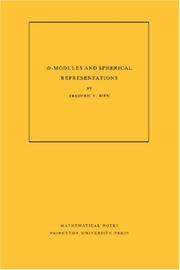
ISBN: 1400862078 9781400862078 0691025177 9780691608327 9780691025179 0691025177 0691608326 9780691608327 Year: 1990 Publisher: Princeton, New Jersey
Abstract | Keywords | Export | Availability | Bookmark
 Loading...
Loading...Choose an application
- Reference Manager
- EndNote
- RefWorks (Direct export to RefWorks)
The theory of D-modules deals with the algebraic aspects of differential equations. These are particularly interesting on homogeneous manifolds, since the infinitesimal action of a Lie algebra consists of differential operators. Hence, it is possible to attach geometric invariants, like the support and the characteristic variety, to representations of Lie groups. By considering D-modules on flag varieties, one obtains a simple classification of all irreducible admissible representations of reductive Lie groups. On the other hand, it is natural to study the representations realized by functions on pseudo-Riemannian symmetric spaces, i.e., spherical representations. The problem is then to describe the spherical representations among all irreducible ones, and to compute their multiplicities. This is the goal of this work, achieved fairly completely at least for the discrete series representations of reductive symmetric spaces. The book provides a general introduction to the theory of D-modules on flag varieties, and it describes spherical D-modules in terms of a cohomological formula. Using microlocalization of representations, the author derives a criterion for irreducibility. The relation between multiplicities and singularities is also discussed at length.Originally published in 1990.The Princeton Legacy Library uses the latest print-on-demand technology to again make available previously out-of-print books from the distinguished backlist of Princeton University Press. These editions preserve the original texts of these important books while presenting them in durable paperback and hardcover editions. The goal of the Princeton Legacy Library is to vastly increase access to the rich scholarly heritage found in the thousands of books published by Princeton University Press since its founding in 1905.
Differentiable manifolds. --- D-modules. --- Representations of groups. --- Lie groups. --- Groups, Lie --- Lie algebras --- Symmetric spaces --- Topological groups --- Group representation (Mathematics) --- Groups, Representation theory of --- Group theory --- Modules (Algebra) --- Differential manifolds --- Manifolds (Mathematics) --- Affine space. --- Algebraic cycle. --- Algebraic element. --- Analytic function. --- Annihilator (ring theory). --- Automorphism. --- Banach space. --- Base change. --- Big O notation. --- Bijection. --- Bilinear form. --- Borel subgroup. --- Cartan subalgebra. --- Cofibration. --- Cohomology. --- Commutative diagram. --- Commutative property. --- Commutator subgroup. --- Complexification (Lie group). --- Conjugacy class. --- Coproduct. --- Coset. --- Cotangent space. --- D-module. --- Derived category. --- Diagram (category theory). --- Differential operator. --- Dimension (vector space). --- Direct image functor. --- Discrete series representation. --- Disk (mathematics). --- Dot product. --- Double coset. --- Eigenfunction. --- Eigenvalues and eigenvectors. --- Endomorphism. --- Euler operator. --- Existential quantification. --- Fibration. --- Function space. --- Functor. --- G-module. --- Gelfand pair. --- Generic point. --- Hilbert space. --- Holomorphic function. --- Homomorphism. --- Hyperfunction. --- Ideal (ring theory). --- Infinitesimal character. --- Inner automorphism. --- Invertible sheaf. --- Irreducibility (mathematics). --- Irreducible representation. --- Levi decomposition. --- Lie algebra. --- Line bundle. --- Linear algebraic group. --- Linear space (geometry). --- Manifold. --- Maximal compact subgroup. --- Maximal torus. --- Metric space. --- Module (mathematics). --- Moment map. --- Morphism. --- Noetherian ring. --- Open set. --- Presheaf (category theory). --- Principal series representation. --- Projective line. --- Projective object. --- Projective space. --- Projective variety. --- Reductive group. --- Riemannian geometry. --- Riemann–Hilbert correspondence. --- Right inverse. --- Ring (mathematics). --- Root system. --- Satake diagram. --- Sheaf (mathematics). --- Sheaf of modules. --- Special case. --- Sphere. --- Square-integrable function. --- Sub"ient. --- Subalgebra. --- Subcategory. --- Subgroup. --- Summation. --- Surjective function. --- Symmetric space. --- Symplectic geometry. --- Tensor product. --- Theorem. --- Triangular matrix. --- Vector bundle. --- Volume form. --- Weyl group.
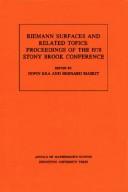
ISBN: 0691082642 0691082677 1400881552 Year: 1981 Publisher: Princeton, N.J.
Abstract | Keywords | Export | Availability | Bookmark
 Loading...
Loading...Choose an application
- Reference Manager
- EndNote
- RefWorks (Direct export to RefWorks)
The description for this book, Riemann Surfaces Related Topics (AM-97), Volume 97: Proceedings of the 1978 Stony Brook Conference. (AM-97), will be forthcoming.
Geometry --- Riemann surfaces --- -517.54 --- Surfaces, Riemann --- Functions --- Congresses --- Conformal mapping and geometric problems in the theory of functions of a complex variable. Analytic functions and their generalizations --- 517.54 Conformal mapping and geometric problems in the theory of functions of a complex variable. Analytic functions and their generalizations --- 517.54 --- Riemann, Surfaces de --- Abstract simplicial complex. --- Affine transformation. --- Algebraic curve. --- Algebraic element. --- Algebraic equation. --- Algebraic surface. --- Analytic function. --- Analytic torsion. --- Automorphic form. --- Automorphic function. --- Automorphism. --- Banach space. --- Basis (linear algebra). --- Boundary (topology). --- Bounded set (topological vector space). --- Cohomology ring. --- Cohomology. --- Commutative property. --- Commutator subgroup. --- Compact Riemann surface. --- Complex analysis. --- Complex manifold. --- Conformal geometry. --- Conformal map. --- Conjugacy class. --- Covering space. --- Diagram (category theory). --- Dimension (vector space). --- Divisor (algebraic geometry). --- Divisor. --- Eigenvalues and eigenvectors. --- Equivalence class. --- Equivalence relation. --- Ergodic theory. --- Existential quantification. --- Foliation. --- Fuchsian group. --- Fundamental domain. --- Fundamental group. --- Fundamental polygon. --- Geodesic. --- Geometric function theory. --- Group homomorphism. --- H-cobordism. --- Hausdorff measure. --- Holomorphic function. --- Homeomorphism. --- Homomorphism. --- Homotopy. --- Hyperbolic 3-manifold. --- Hyperbolic manifold. --- Hyperbolic space. --- Infimum and supremum. --- Injective module. --- Interior (topology). --- Intersection form (4-manifold). --- Isometry. --- Isomorphism class. --- Jordan curve theorem. --- Kleinian group. --- Kähler manifold. --- Limit point. --- Limit set. --- Manifold. --- Meromorphic function. --- Metric space. --- Mostow rigidity theorem. --- Möbius transformation. --- Poincaré conjecture. --- Pole (complex analysis). --- Polynomial. --- Product topology. --- Projective variety. --- Quadratic differential. --- Quasi-isometry. --- Quasiconformal mapping. --- Quotient space (topology). --- Radon–Nikodym theorem. --- Ricci curvature. --- Riemann mapping theorem. --- Riemann sphere. --- Riemann surface. --- Riemannian geometry. --- Riemannian manifold. --- Schwarzian derivative. --- Strictly convex space. --- Subgroup. --- Submanifold. --- Surjective function. --- Tangent space. --- Teichmüller space. --- Theorem. --- Topological conjugacy. --- Topological space. --- Topology. --- Uniformization theorem. --- Uniformization. --- Uniqueness theorem. --- Unit disk. --- Vector bundle.
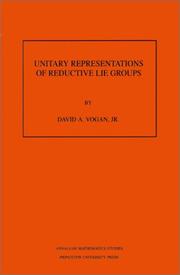
ISBN: 0691084815 0691084823 1400882389 9780691084824 9780691084817 Year: 1987 Publisher: Princeton (N.J.): Princeton university press,
Abstract | Keywords | Export | Availability | Bookmark
 Loading...
Loading...Choose an application
- Reference Manager
- EndNote
- RefWorks (Direct export to RefWorks)
This book is an expanded version of the Hermann Weyl Lectures given at the Institute for Advanced Study in January 1986. It outlines some of what is now known about irreducible unitary representations of real reductive groups, providing fairly complete definitions and references, and sketches (at least) of most proofs. The first half of the book is devoted to the three more or less understood constructions of such representations: parabolic induction, complementary series, and cohomological parabolic induction. This culminates in the description of all irreducible unitary representation of the general linear groups. For other groups, one expects to need a new construction, giving "unipotent representations." The latter half of the book explains the evidence for that expectation and suggests a partial definition of unipotent representations.
Lie groups --- Representations of Lie groups --- Lie groups. --- Representations of Lie groups. --- 512.81 --- Groups, Lie --- Lie algebras --- Symmetric spaces --- Topological groups --- 512.81 Lie groups --- Abelian group. --- Adjoint representation. --- Annihilator (ring theory). --- Atiyah–Singer index theorem. --- Automorphic form. --- Automorphism. --- Cartan subgroup. --- Circle group. --- Class function (algebra). --- Classification theorem. --- Cohomology. --- Commutator subgroup. --- Complete metric space. --- Complex manifold. --- Conjugacy class. --- Cotangent space. --- Dimension (vector space). --- Discrete series representation. --- Dixmier conjecture. --- Dolbeault cohomology. --- Duality (mathematics). --- Eigenvalues and eigenvectors. --- Exponential map (Lie theory). --- Exponential map (Riemannian geometry). --- Exterior algebra. --- Function space. --- Group homomorphism. --- Harmonic analysis. --- Hecke algebra. --- Hilbert space. --- Hodge theory. --- Holomorphic function. --- Holomorphic vector bundle. --- Homogeneous space. --- Homomorphism. --- Induced representation. --- Infinitesimal character. --- Inner automorphism. --- Invariant subspace. --- Irreducibility (mathematics). --- Irreducible representation. --- Isometry group. --- Isometry. --- K-finite. --- Kazhdan–Lusztig polynomial. --- Langlands decomposition. --- Lie algebra cohomology. --- Lie algebra representation. --- Lie algebra. --- Lie group action. --- Lie group. --- Mathematical induction. --- Maximal compact subgroup. --- Measure (mathematics). --- Minkowski space. --- Nilpotent group. --- Orbit method. --- Orthogonal group. --- Parabolic induction. --- Principal homogeneous space. --- Principal series representation. --- Projective space. --- Pseudo-Riemannian manifold. --- Pullback (category theory). --- Ramanujan–Petersson conjecture. --- Reductive group. --- Regularity theorem. --- Representation of a Lie group. --- Representation theorem. --- Representation theory. --- Riemann sphere. --- Riemannian manifold. --- Schwartz space. --- Semisimple Lie algebra. --- Sheaf (mathematics). --- Sign (mathematics). --- Special case. --- Spectral theory. --- Sub"ient. --- Subgroup. --- Support (mathematics). --- Symplectic geometry. --- Symplectic group. --- Symplectic vector space. --- Tangent space. --- Tautological bundle. --- Theorem. --- Topological group. --- Topological space. --- Trivial representation. --- Unitary group. --- Unitary matrix. --- Unitary representation. --- Universal enveloping algebra. --- Vector bundle. --- Weyl algebra. --- Weyl character formula. --- Weyl group. --- Zariski's main theorem. --- Zonal spherical function. --- Représentations de groupes de Lie --- Groupes de lie --- Representation des groupes de lie
| Listing 1 - 8 of 8 |
Sort by
|

 Search
Search Feedback
Feedback About UniCat
About UniCat  Help
Help News
News